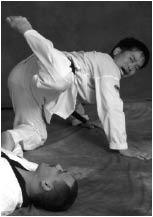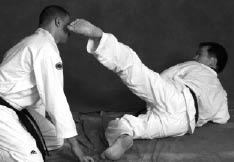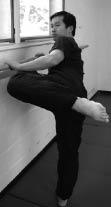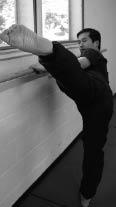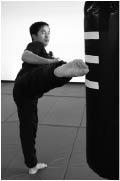Complete Kicking (8 page)
Authors: Turtle Press

SELF-DEFENSE APPLICATIONS
Kick over the opponent’s strike, using your longer range kick to your advantage.
From the ground, use the ball of your foot to strike the opponent’s chest. Place your hands on the ground to support your body and add power.
A low kick to the rear of the knee will cause an assailant to fall backward.
On the ground, you can use a downward roundhouse kick to a fallen opponent.
Maintain distance from your opponent on the ground with a roundhouse kick to the head.
common mistakes
MISTAKE 1: The most common mistake when executing roundhouse kick is incomplete rotation of the hip.
SOLUTION: For maximum power, rotate your body fully to align your hip, head and feet, and to put your bodyweight into your kick.
MISTAKE 2: Over-rotation of the body during and after kicking.
SOLUTION: It can be easy to over-rotate your body in an effort to make your kick more powerful, but power comes from speed and the snap of your hips, not from turning your upper body, so focus on these instead.
MISTAKE 3: Kicking in a wide arc.
SOLUTION: Bring your knee up straight at the target and then pivot tightly. Avoid letting your leg swing wide; instead snap it at the target.
BOTTOM LINE: Keep your opponent in sight at all times; kick fast and forcefully; repose as quickly as you can.
• remember
1. Keep your head straight.
2. Tuck your chin down.
3. Rotate your hip fully.
4. Move your arms naturally around your body for balance and power.
• avoid
1. Uncommitted kicking
2. Premature kicking (bad timing)
3. Tilting your head
4. Over-rotating your body
5. Kicking in a wide arc
6. Kicking at the wrong distance (too close to opponent)
roundhouse kick form drill
To improve your kicking, practice roundhouse kick holding a support. Start with your back to the wall and your kicking foot in the rear. Pivot so your hip faces the wall and your chest is parallel to the wall. Standing close to the wall will prevent your from over-rotating your hips or knees and from hunching your upper body forward. Finally, extend your kicking leg and hold briefly. Your body (chest, hips, kicking leg) should be parallel to the wall when your kick is fully extended.
Roundhouse kick power drill
The heavy bag is an excellent tool for developing power. Here are examples of heavy bag kicking drills: 1) 3 sets of 15 kicks with each leg at normal power and speed. 2) Be sure you’re fully warmed up, then kick as high as you can 20 times on each side. 3) Kick as fast and as powerfully as you can to a middle level target, alternating legs for 50 kicks on each side.
Roundhouse kick precision drill
Ideally, you should develop precision from the start of the learning process. A good way to do this is to always have a specific target for each kick. You can use a hand target held by a partner, a ball suspended on a string or a heavy bag. When you practice with the heavy bag, mark it with tape as shown here so you do not fall into the habit of randomly kicking the bag. Whether you are training for precision with slow controlled kicks or you are working on power and speed, stay disciplined and try to hit your target every time.
Other books
The Swordmage Trilogy Bundle, Volumes 1-3 by Martin Hengst
Savor Me by Aly Martinez
The Path of Silence by Edita A. Petrick
Pwned by Camp, Shannen
We Saw Spain Die by Preston Paul
Dead & Gone by Jonathan Maberry
Apart at the Seams by Marie Bostwick
Twice Upon a Time by Kate Forster
Beowulf by Neil Gaiman
The Round Table (Space Lore Book 3) by Chris Dietzel



